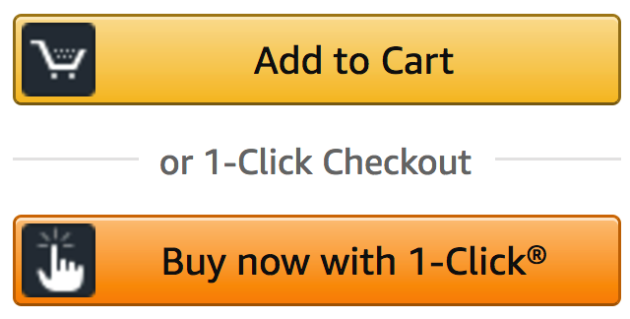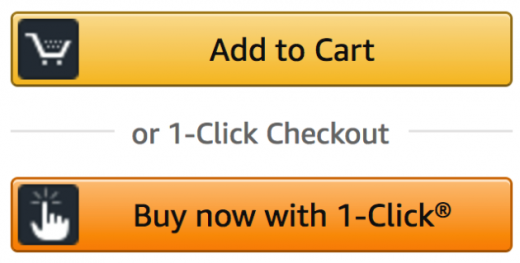Amazon One-Click Checkout Patent Has Expired. Should Merchants Use It?
— August 1, 2019
It’s approaching two years since Amazon’s patented one-click checkout feature expired on September 11, 2017, granting license-and-lawsuit free use for online merchants. During the patent’s life, Amazon legally strong armed chief rival Barnes and Noble into removing its own version of the feature, while licensing to Apple to the tune of $ 1 million per year.
With an estimated half of Amazon buyers using one-click checkout, the industry waited with baited breath for its release. But despite the opportunity for sellers, very few have implemented it since its release. Why not? And is it right for your business?
How one-click checkout works
One-click allows signed-in customers to purchase directly from any product page or cart, bypassing checkout entirely. The action authorizes a purchase, pulling the customer’s on-file payment information and shipping address. Customers have a window to edit or cancel orders before they’re processed (Amazon gives 30 minutes), or to add to orders for combined and free shipping.

Why one-click might not stick
Your commerce platform
Thanks to the 17 year shut out, one-click checkout was never an out-of-the-box feature for any commercial ecommerce platform (until Magento broke the ice with its Instant Purchase feature in December 2017). Adding radical new features to monolithic commerce systems is time consuming and risky — especially for critical functions such as checkout. One-click buying must be integrated with product pages, cart, checkout and customer accounts. Modifying code across multiple commerce services introduces risk and requires extensive regression testing, and realistically could take a year or more to implement within large systems such as Oracle, hybris, Websphere or Demandware, or an in-house build.
One-click also impacts order management. You’ll likely need to modify internal policies and processes, for example holding orders for X amount of time for modifications or combined shipping. If your commerce platform is integrated with a third-party OMS, satisfying these requirements may not even be possible.
Your customers
Amazon customers are unicorns. Half of US households are Prime Members. They keep their addresses and payment methods up-to-date, and are perpetually signed in to ‘Zon. They don’t worry about shipping charges and other unhappy surprises in checkout. They don’t jump-the-cart in hunt of coupon codes. The most loyal bypass the web and go straight to Echo.
Chances are, your customers purchase far less frequently. Their addresses change, their credit cards expire. Their cookies clear, and they forget their usernames and passwords. They prefer guest checkout, even when they’ve bought from you before (one third will abandon checkout because they can’t remember the password).
One-click shopping isn’t necessarily frictionless. On most non-Zon sites, customers want to qualify for free shipping, apply coupons and promotions, choose home delivery or store pickup and have full visibility into the details of their order. Because one-click buttons aren’t yet mainstream, customers may not understand how they work on your site, especially when labeled as Instant Purchase on product pages.
Finally at peace, Barnes and Noble has reinstated their one-click buying option.
Customers also want their order fast. Most Amazon buyers don’t realize their one-click orders ship up to 3 days later — they may not care. When competing against Amazon, exceeding customer expectations matters — especially for gifts and holiday orders. Insta-buying may lead to crying.
Your KPIs
Merchants who’ve tested Magento’s Instant Purchase claim it shortens time-to-order by up to 90%. Not surprising when you cut out all checkout steps. But time-to-order shouldn’t be optimized at the expense of average order value, items per order and profit margin.
Without a cart, there’s no cart to abandon — but there’s no cart to build. There’s no cross-sell or upsell opportunity. And cart totals may not be high enough to cover customer acquisition costs or shipping subsidies. Without A/B testing one-click, it’s difficult to measure how much instant purchase cannibalizes from standard checkout.
But you can’t A/B test one-click checkout without building it first! And that’s impossible unless you’re using microservices and can run two checkouts code head-to-head. But as mentioned, one-click involves more than just the checkout service.
Regardless, conventional A/B testing tools are built for on-page tests that can be modified through javascript, not to test hard-coded changes. What’s more, one-click is only displayed to logged in users. Most A/B testing tools aren’t sophisticated enough to segment this way and understand the use case.
The case for frictionless payments
When Amazon’s one-click checkout patent was conceived, desktop was the only digital device in town. Today, interest in frictionless digital payment spans online, in-store, mobile and even IoT devices (like Staples’ Easy Button and Carnival’s Ocean Medallion). Buying through chatbots, messenger apps, social platforms, wearables or sensors is not science fiction.
Unless your digital roadmap needs to accommodate native payment through such “commerce everywhere” touchpoints, you’ll survive with traditional online checkout, or the addition of digital wallets like PayPal One Touch or Apple Pay as payment options.
Digital & Social Articles on Business 2 Community
(55)


